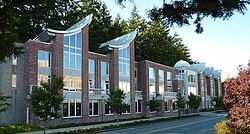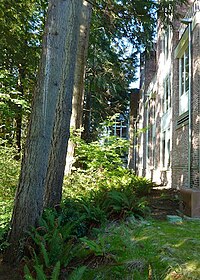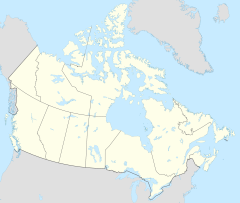| C.K. Choi Building | |
|---|---|
 C. K. Choi Building, street facade, c.2010 | |
| General information | |
| Type | University Office Building |
| Address | 1855 West Mall, UBC, Vancouver |
| Country | Canada |
| Coordinates | 49°16′02″N 123°15′30″W / 49.267132°N 123.258405°W |
| Current tenants | Institute of Asian Research |
| Completed | 1996 |
| Owner | University of British Columbia |
| Technical details | |
| Floor count | 3 storeys |
| Floor area | 34,400 sq.ft. |
| Design and construction | |
| Architecture firm | Matsuzaki Wright Architects |
| Website | |
| www.iar.ubc.ca | |
The C. K. Choi Building is an educational building on the campus of the University of British Columbia (UBC) known for its sustainable design features. [1] [2] [3]Named for businessman and philanthropist Dr. Cheung-Kok Choi, [4] [5] the building houses UBC's Institute of Asian Research. The architecture of the building implements Asian motifs. [6] [7] [8] [9]
Institute of Asian Research
The Institute of Asian Research, headquartered in the C. K. Choi building, is a research institute founded in 1978 as a major Canadian research centre for Asia.
Design team

- Architects + Sustainability: Matsuzaki Wright [7]
- Landscape Architects: Cornelia Hahn Oberlander
- Structural Engineers: Read Jones Christoffersen
- Mechanical Engineers: Keen Engineering Co. Ltd. (now Stantec)
- Electrical Engineers: Robert Freundlich & Associates Ltd.
- Owner: University of British Columbia, Freda Pagani, Campus Planning and Development
- Owner's Sustainability Advisor: Bob Berkebile, BNIM
Sustainable features


The C. K. Choi building was designed to be sustainable and energy-efficient. [10] [11] Its sustainable features include:
- Location: built on an existing parking lot surrounded by large trees to reduce heat gain
- Form: narrow profile to minimize site impact and provide natural light inside
- Recycling: approximately 50% of building materials were recycled or re-used
- Sanitation: composting toilets were initially used, [12] but were removed when the compost was found to be detrimental to the environment
- Stormwater: the building's gutters collect water in a tank for irrigation purposes [13]
- Energy: sensors turn off lights when not in use, heavy use of insulation preserves indoor temperature, steam vault utilizes waste heat
- Finishes: most interior surfaces use minimal material, such as unpainted metal and a lack of suspended ceilings
- Air quality: carpet adhesives and solvent finishes were not used in construction, to minimize air pollution
- Ventilation: ventilation is non-mechanical and provides fresh air from windows
- Heat: surplus heat radiating into the ground is collected and utilized
- Electricity: uses only surplus electricity from adjacent buildings [8]

Awards
- 1996 BC Hydro Energy Smart Award [14]
- 1996 British Columbia Earth Award, Building Owners and Managers Association [15]
- 1997 Building Award of Excellence, Consulting Engineers of British Columbia [16]
- 1998 List of Canadian awards, Architectural Institute of British Columbia
- 1998 Award for Innovation Excellence, Architectural Institute of British Columbia (Matsuzaki Wright Architects Inc.) [14]
- 2000 Earth Day 2000 Top Ten Award, American Institute of Architects Committee on the Environment [17]
References
- ^ "UBC press release 1996-10-06". Archived from the original on 4 April 2011. Retrieved 20 October 2010.
- ^ "Cascadia Building Council" (PDF). Archived from the original (PDF) on 24 October 2007. Retrieved 20 October 2010.
- ^ Cole and Steiger, p.7
- ^ IAR In Memoriam Archived 14 September 2015 at the Wayback Machine
- ^ "Community Leaders". Archived from the original on 7 March 2012. Retrieved 22 October 2010.
- ^ "UBC Sustainability". Archived from the original on 14 November 2010. Retrieved 21 October 2010.
- ^ a b "Eva Matsuzaki". The Canadian Encyclopedia. Retrieved 6 September 2019.
- ^ a b IAR History Archived 2 October 2011 at the Wayback Machine
- ^ CascadiaBC Archived 6 January 2011 at the Wayback Machine
- ^ Gudrun, Will. Retrieved online October 2010
- ^ C.K. Choi Building evaluation Archived 6 July 2011 at the Wayback Machine
- ^ Clivus Multrum composting toilets
- ^ Seeds of Sustainability: B.C. Lower Mainland Buildings
- ^ a b "Green Value case studies" (PDF). Archived from the original (PDF) on 17 July 2011. Retrieved 22 October 2010.
- ^ "BOMA BC". Archived from the original on 29 November 2010. Retrieved 22 October 2010.
- ^ University of Waterloo - case study
- ^ AIA/COTE top ten Earth Day Award 2000. Retrieved 2013-12-12
Bibliography and External links
- IAR official website Archived 3 August 2018 at the Wayback Machine
- Gudrun, Will. A Constructive Idea, Vancouver Courier, pp. 1,4-5. Vol. 87, No.48, 16 June 1996
- Alive.com - UBC Uses Eco-Sense
- BuildingGreen.com
- Cascadia Building Council
- Cole, Raymond J. Green Buildings: In Transit to a Sustainable World, Canadian Architect, July 1996, Volume 41, No. 7, pp. 12–13. Retrieved online October 2010.
- Cole, Ray, and Steiger, Michelle, Environmental Research Group, School of Architecture University of British Columbia: GREEN BUILDINGS - GREY OCCUPANTS?. Web-Proceedings: American Institute of Architects/US Green Building Council – Mainstreaming Green Conference, Chattanooga, TN, 14-19 October 1999
- Cornelia Oberlander - landscape and building features
- Commission for Environmental Cooperation
- Cascadia Building Council
- Environmental News Network, 9 September 2008
- GreenStudentU - British Columbia's Sewage-Free Building
- IAR - A Constructive Idea
- Marques, Jorge, and Pagani, Freda, and Perdue, Joanne. Process Makes Product: The C.K. Choi Building For The Institute of Asian Research at the University of British Columbia (post occupancy evaluation through December 1998) Retrieved online October 2010.
- Metaefficient.com
- MetroVancouver.org Green Value case studies
- Old to New - Design Guide: Salvaged Building Materials in New Construction, 3rd Edition, 2002
- Prince, Richard E., UBC Department of Fine Arts. Script for an Asian Landscape, p. 18. Design for a New Millenium, ed. E. Laquian (1996). Institute of Asian Research, Vancouver. Retrieved online October 2010.
- Seeing With New Eyes
- SustainableBuilding.com
- Sustainability TV - A Tour of the C.K. Choi Building
- Treehugger.com: Vancouver Building Goes Off-Pipe
- University of Waterloo - case study
| C.K. Choi Building | |
|---|---|
 C. K. Choi Building, street facade, c.2010 | |
| General information | |
| Type | University Office Building |
| Address | 1855 West Mall, UBC, Vancouver |
| Country | Canada |
| Coordinates | 49°16′02″N 123°15′30″W / 49.267132°N 123.258405°W |
| Current tenants | Institute of Asian Research |
| Completed | 1996 |
| Owner | University of British Columbia |
| Technical details | |
| Floor count | 3 storeys |
| Floor area | 34,400 sq.ft. |
| Design and construction | |
| Architecture firm | Matsuzaki Wright Architects |
| Website | |
| www.iar.ubc.ca | |
The C. K. Choi Building is an educational building on the campus of the University of British Columbia (UBC) known for its sustainable design features. [1] [2] [3]Named for businessman and philanthropist Dr. Cheung-Kok Choi, [4] [5] the building houses UBC's Institute of Asian Research. The architecture of the building implements Asian motifs. [6] [7] [8] [9]
Institute of Asian Research
The Institute of Asian Research, headquartered in the C. K. Choi building, is a research institute founded in 1978 as a major Canadian research centre for Asia.
Design team

- Architects + Sustainability: Matsuzaki Wright [7]
- Landscape Architects: Cornelia Hahn Oberlander
- Structural Engineers: Read Jones Christoffersen
- Mechanical Engineers: Keen Engineering Co. Ltd. (now Stantec)
- Electrical Engineers: Robert Freundlich & Associates Ltd.
- Owner: University of British Columbia, Freda Pagani, Campus Planning and Development
- Owner's Sustainability Advisor: Bob Berkebile, BNIM
Sustainable features


The C. K. Choi building was designed to be sustainable and energy-efficient. [10] [11] Its sustainable features include:
- Location: built on an existing parking lot surrounded by large trees to reduce heat gain
- Form: narrow profile to minimize site impact and provide natural light inside
- Recycling: approximately 50% of building materials were recycled or re-used
- Sanitation: composting toilets were initially used, [12] but were removed when the compost was found to be detrimental to the environment
- Stormwater: the building's gutters collect water in a tank for irrigation purposes [13]
- Energy: sensors turn off lights when not in use, heavy use of insulation preserves indoor temperature, steam vault utilizes waste heat
- Finishes: most interior surfaces use minimal material, such as unpainted metal and a lack of suspended ceilings
- Air quality: carpet adhesives and solvent finishes were not used in construction, to minimize air pollution
- Ventilation: ventilation is non-mechanical and provides fresh air from windows
- Heat: surplus heat radiating into the ground is collected and utilized
- Electricity: uses only surplus electricity from adjacent buildings [8]

Awards
- 1996 BC Hydro Energy Smart Award [14]
- 1996 British Columbia Earth Award, Building Owners and Managers Association [15]
- 1997 Building Award of Excellence, Consulting Engineers of British Columbia [16]
- 1998 List of Canadian awards, Architectural Institute of British Columbia
- 1998 Award for Innovation Excellence, Architectural Institute of British Columbia (Matsuzaki Wright Architects Inc.) [14]
- 2000 Earth Day 2000 Top Ten Award, American Institute of Architects Committee on the Environment [17]
References
- ^ "UBC press release 1996-10-06". Archived from the original on 4 April 2011. Retrieved 20 October 2010.
- ^ "Cascadia Building Council" (PDF). Archived from the original (PDF) on 24 October 2007. Retrieved 20 October 2010.
- ^ Cole and Steiger, p.7
- ^ IAR In Memoriam Archived 14 September 2015 at the Wayback Machine
- ^ "Community Leaders". Archived from the original on 7 March 2012. Retrieved 22 October 2010.
- ^ "UBC Sustainability". Archived from the original on 14 November 2010. Retrieved 21 October 2010.
- ^ a b "Eva Matsuzaki". The Canadian Encyclopedia. Retrieved 6 September 2019.
- ^ a b IAR History Archived 2 October 2011 at the Wayback Machine
- ^ CascadiaBC Archived 6 January 2011 at the Wayback Machine
- ^ Gudrun, Will. Retrieved online October 2010
- ^ C.K. Choi Building evaluation Archived 6 July 2011 at the Wayback Machine
- ^ Clivus Multrum composting toilets
- ^ Seeds of Sustainability: B.C. Lower Mainland Buildings
- ^ a b "Green Value case studies" (PDF). Archived from the original (PDF) on 17 July 2011. Retrieved 22 October 2010.
- ^ "BOMA BC". Archived from the original on 29 November 2010. Retrieved 22 October 2010.
- ^ University of Waterloo - case study
- ^ AIA/COTE top ten Earth Day Award 2000. Retrieved 2013-12-12
Bibliography and External links
- IAR official website Archived 3 August 2018 at the Wayback Machine
- Gudrun, Will. A Constructive Idea, Vancouver Courier, pp. 1,4-5. Vol. 87, No.48, 16 June 1996
- Alive.com - UBC Uses Eco-Sense
- BuildingGreen.com
- Cascadia Building Council
- Cole, Raymond J. Green Buildings: In Transit to a Sustainable World, Canadian Architect, July 1996, Volume 41, No. 7, pp. 12–13. Retrieved online October 2010.
- Cole, Ray, and Steiger, Michelle, Environmental Research Group, School of Architecture University of British Columbia: GREEN BUILDINGS - GREY OCCUPANTS?. Web-Proceedings: American Institute of Architects/US Green Building Council – Mainstreaming Green Conference, Chattanooga, TN, 14-19 October 1999
- Cornelia Oberlander - landscape and building features
- Commission for Environmental Cooperation
- Cascadia Building Council
- Environmental News Network, 9 September 2008
- GreenStudentU - British Columbia's Sewage-Free Building
- IAR - A Constructive Idea
- Marques, Jorge, and Pagani, Freda, and Perdue, Joanne. Process Makes Product: The C.K. Choi Building For The Institute of Asian Research at the University of British Columbia (post occupancy evaluation through December 1998) Retrieved online October 2010.
- Metaefficient.com
- MetroVancouver.org Green Value case studies
- Old to New - Design Guide: Salvaged Building Materials in New Construction, 3rd Edition, 2002
- Prince, Richard E., UBC Department of Fine Arts. Script for an Asian Landscape, p. 18. Design for a New Millenium, ed. E. Laquian (1996). Institute of Asian Research, Vancouver. Retrieved online October 2010.
- Seeing With New Eyes
- SustainableBuilding.com
- Sustainability TV - A Tour of the C.K. Choi Building
- Treehugger.com: Vancouver Building Goes Off-Pipe
- University of Waterloo - case study
